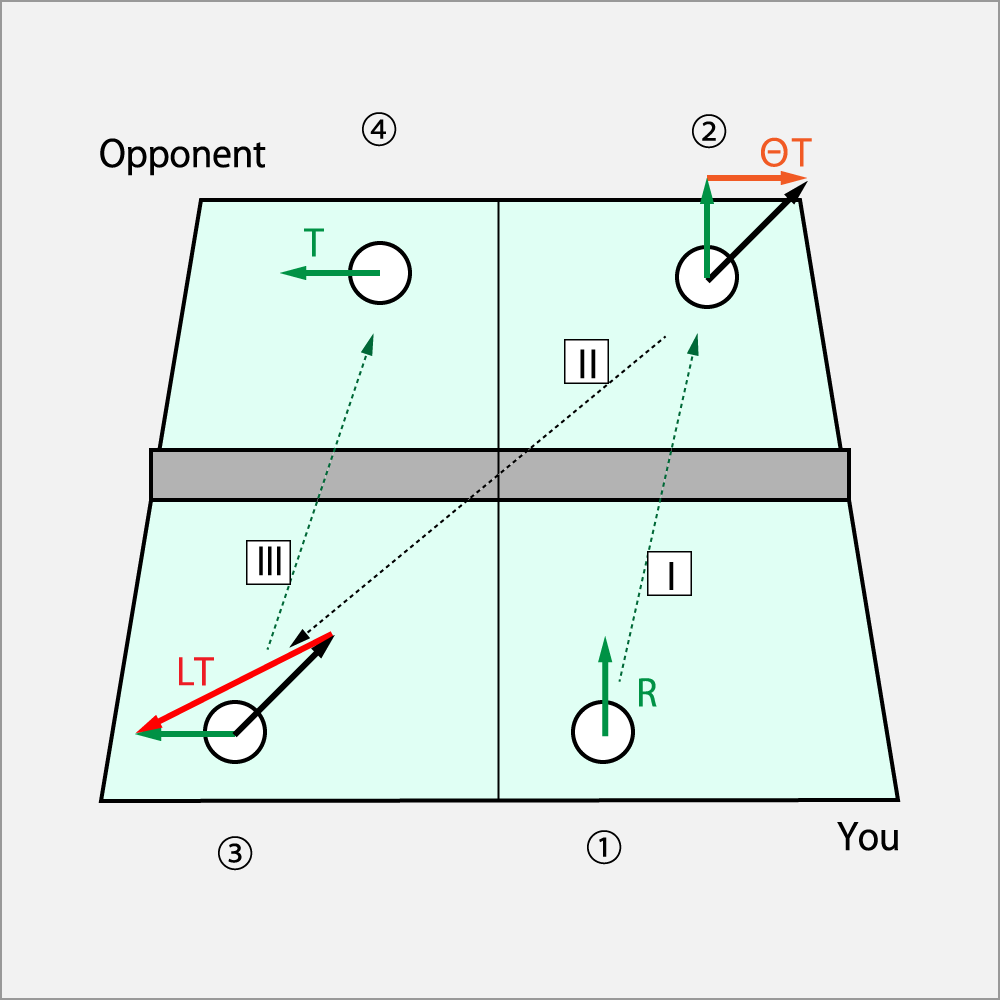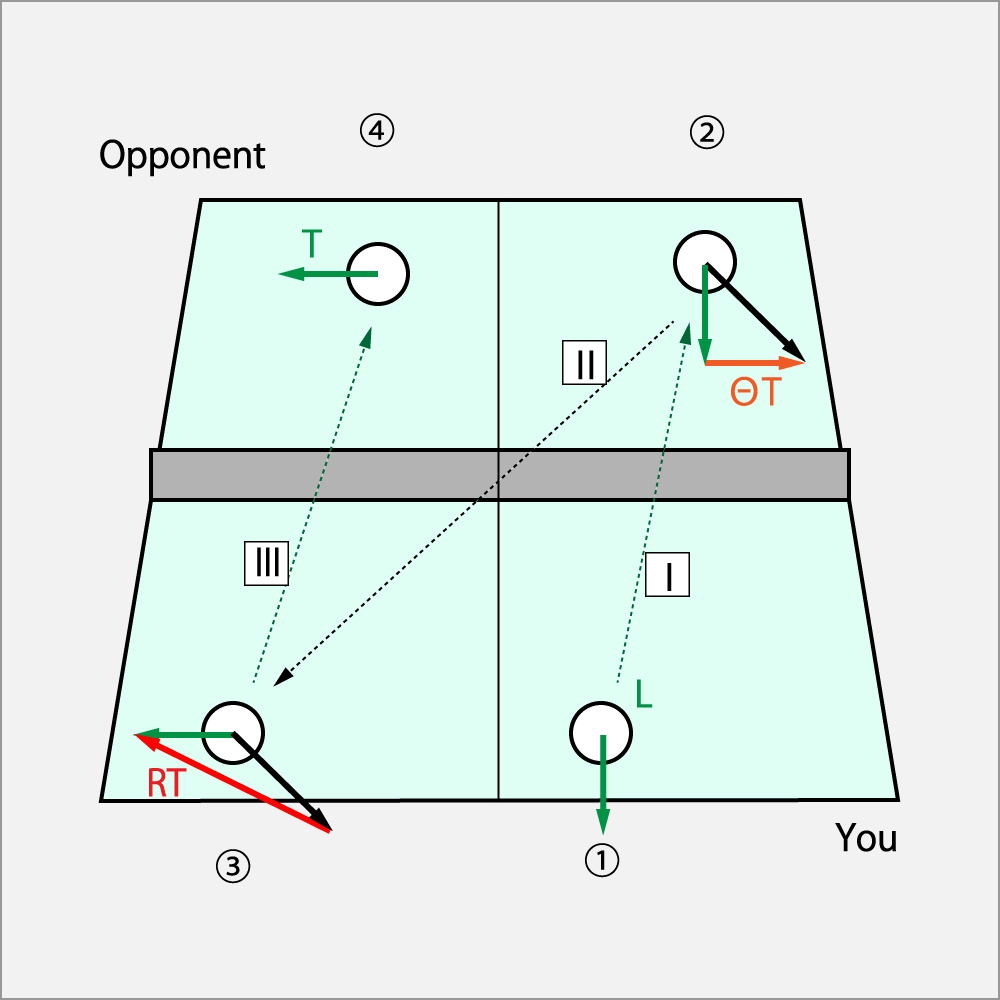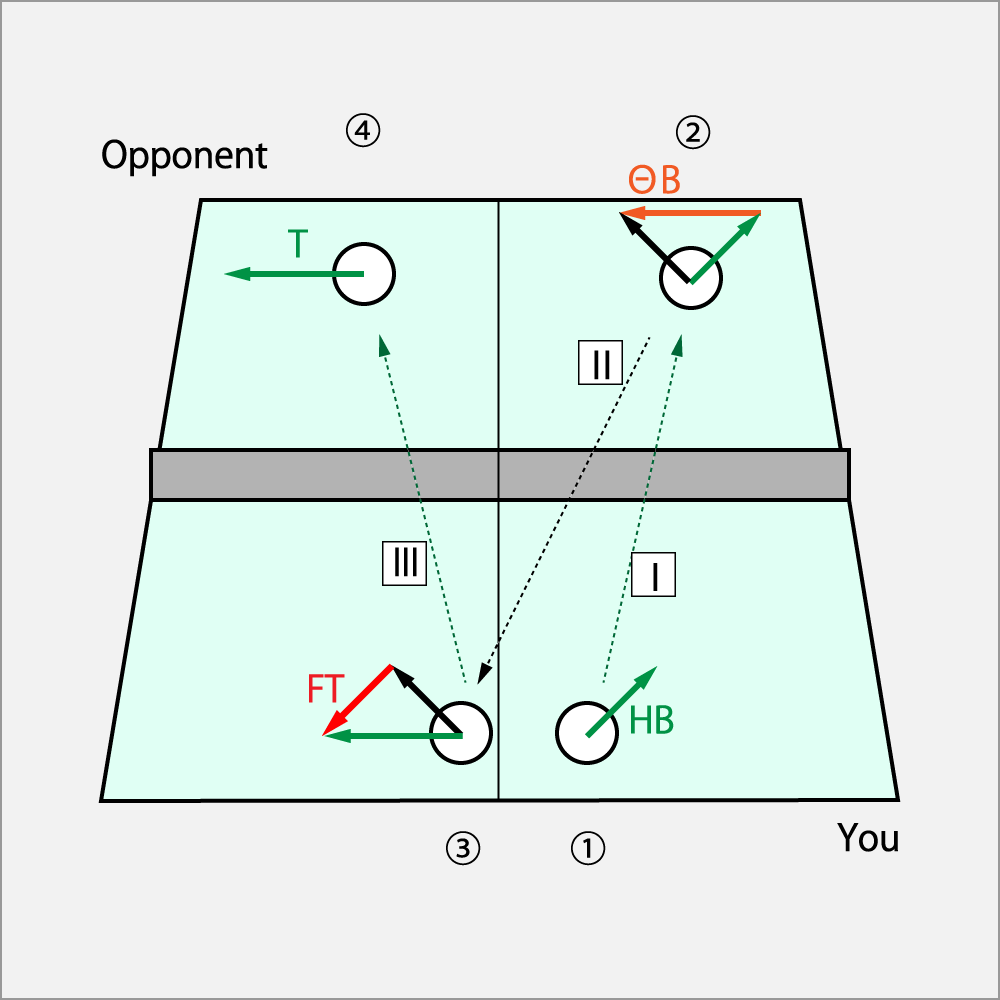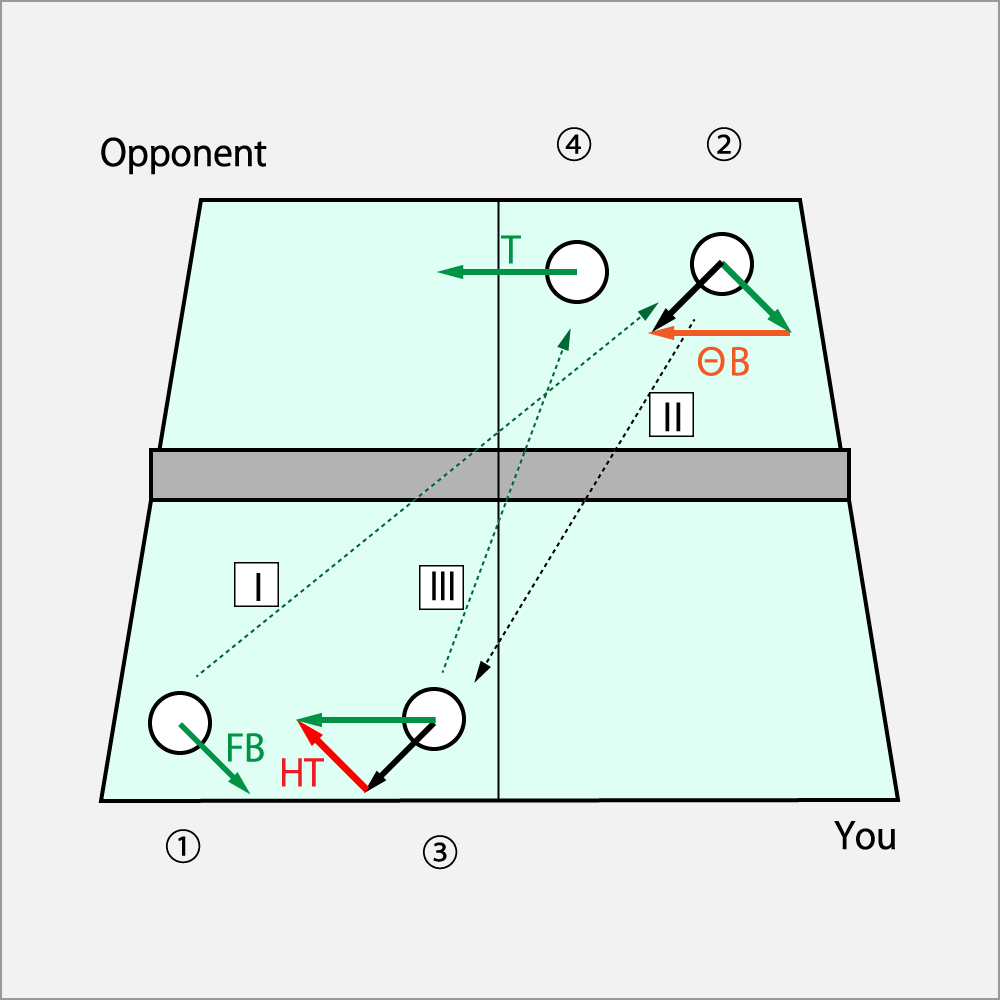Part 2. Think Tactics acoording to Vectors
2.9. The Third Pitch Attack
Already, we have learned the way of receiving by spin composition. You can predict the spin direction by spin composition when the opponent has returned your service unconsciously. This is the theme here how to swing should be when you attack the opponent by the third pitch with a Drive.
After studying the techniques here, you will know how easy the third pitch attack is. As your attack is going well, you will become a believer for the rationality of spin composition, and start thinking about new tricks. In addition, when you can understand following "laws of the third pitch attack", you will be able to make various attacks. Your technical quality of table tennis will change dramatically.
Continuing with the same offensive way, the opponent also gets used to. So, you need the opponent confused by changing the service.
2.9.1. The service on Curve and The third pitch attack by Shoot⋅Drive

Let's look at the order of the ball hitting.
① You have serviced with Curve (R) to the opponent's racket backside deeply on the line Ⅰ.
② The opponent receives the spin on the Ⅰ with ΘDrive (ΘT). As a result, it is returned with Curve⋅Cut (RB) on the Ⅱ.
③ You add Shoot⋅Drive (LT) to Curve⋅Cut (RB) returned on the Ⅱ, and return it as Drive (T) on the Ⅲ at the ④.
As you can see in the vector diagram, in order to finish at the ④, the Shoot⋅Drive (LT) added at the ③ is required to give strongly.
Equation is as follows. Because ΘDrive is the same as the Cut,
Curve⋅Cut = Curve + ΘDrive
Drive = Curve⋅Cut + Shoot⋅Drive
When expressed in English initials,
RB = R + ΘT
T = RB + LT (However LT≥RB)
To summarize the story, you should serve on Curve, and finish by Shoot⋅Drive.
Although this figure shows the ball returned your racket back side. in the case the ball returned your racket fore side, you need to add the same spin to the ball.
2.9.2. The service on Shoot and The third pitch attack by Curve⋅Drive

Let's look at the order of the ball hitting.
① You have serviced with Shoot (L) to the opponent's racket backside deeply on the line Ⅰ.
② The opponent receives the spin on the Ⅰ with ΘDrive (ΘT). As a result, it is returned with Shoot⋅Cut (LB) on the Ⅱ.
③ You add Curve⋅Drive (RT) to Shoot⋅Cut (LB) returned on the Ⅱ, and return it as Drive (T) on the Ⅲ at the ④.
As you can see in the vector diagram, in order to finish at the ④, the Curve⋅Drive (RT) added at the ③ is required to give strongly.
Equation is as follows. Because ΘDrive is the same as the Cut,
Shoot⋅Cut = Shoot + ΘDrive
Drive = Shoot⋅Cut + Shoot⋅Drive (However Curve⋅Drive≥Shoot⋅Cut)
When expressed in English initials,
LB = L + ΘT
T = LB + RT (However RT≥LB)
To summarize the story, you should serve on Shoot, and finish by Shoot⋅Drive.
The left figure shows that the ball returned to the back side of your racket. In the case the ball returned to the fore side, you need to add the same spin to the ball.
2.9.3. The first law of the third pitch attack
If you can predict the opponent to receive ΘDrive or block, you will be able to punch out the ball with Drive at third pitch attack easily.
In the section 2.9.1, you serve by Curve at the ①, let the opponent receive it by ΘDrive at the ②, you attack it by Shoot⋅Drive at the ③.
In the section 2.9.2, you serve by Shoot at the ①, let the opponent receive it by ΘDrive at the ②, you attack it by Curve⋅Drive at the ③.
From the above, Since your serve spin is remaining even after the opponent received, you are to make a third pitch attack from these clues.
So, it also hold true the following combinations.
Curve = Curve⋅Drive +ΘDrive
Drive = Curve + Shoot⋅Drive
or,
Shoot = Shoot⋅Drive +ΘDrive
Drive = Shoot + Curve⋅Drive
Thus, the following rule holds.
<The first law of the third pitch attack>
If the opponent is going to receive your service with Drive or block. And when you serve a sidespin and then just add a Drive with counter-side-spin to the return to offset the sidespin of your own service at the third pitch, the ball will return as Drive to the opponent.
The important thing is that, add a Drive to the counter side of the spin as to rewind the sidespin of a service at the third pitch.
2.9.4. The service on Hcork⋅Cut and The third pitch attack by Fcork⋅Drive

① You have serviced with Hcork⋅Cut(HB) to the opponent's raket backside on the Ⅰ.
② The opponent receives the spin on the Ⅰ with ΘCut (ΘB). As a result, it is returned with Shoot·Drive (HT) on the Ⅱ
③ You add Fcork⋅Drive (FT) to Hcork·Drive (HT) on the Ⅱ, and return it as Drive (T) on the Ⅲ at the ④.
Equation is as follows. Because ΘDrive is the same as the Cut,
Hcork⋅Drive = Fcork⋅Cut + ΘCut
Drive= Hcork⋅Drive + Fcork⋅Drive
When it expressed in English initials,
HT = HB + ΘB
T = HT + FT
To summarize the story, you should serv on Hcork⋅Cut (HB), and finish by Fcork⋅Drive (FT).
Swing with ③Fcork⋅Drive towards the left side, even if we know in the head, our body is not moving on like that.
At first it may not be easily. But you will be able to get this technique soon.
When you have mastered this, you will be able to understand the spin composition really.
2.9.5. The service on Fcork⋅Cut and The third attack by Hcork⋅Drive

① You have serviced with Fcork⋅Cut(FB)to the opponent's racket backside on the Ⅰ.
② The opponent receives the spin on the Ⅰ with ΘCut (ΘB). As a result, it is returned with Ccork⋅Drive (FT) on the Ⅱ
③ You add Hcork⋅Drive (HT) to Fcork·Drive (FT) returned on the Ⅱ, and return it as Drive (T) on the Ⅲ at the ④.
Equation is as follows. Because ΘDrive is the same as the Cut,
Fcork⋅Drive = Fcork⋅Cut + ΘCut
Drive = Fcork⋅Drive + Hcork⋅Drive
When it expressed in English initials,
FT = FB + ΘB
T = FT + HT
To summarize the story, you should service on Fcork⋅Cut, and finish by Hcork⋅Drive.
Swing with ③Hcork⋅Drive towards the right side, even if we know in the head, our body is not moving on like that.
You may feel not easily at first. But you will be able to get this technique soon.
Now, you have mastered the new swing.
2.9.6. The second law of the third pitch attack
Actually, if you can predict the opponent receives the service with ΘCut or let him/her receive it with ΘCut,
you can make various chances of third attack.
In the section 2.9.4, you serve by Hcork⋅Cut (HB) at the point ①, let the opponent receive it by ΘCut(T) at the ②, you attack it by Hcork⋅Drive (HT) at the ③.
In the section 2.9.5, you serve by Fcork⋅Cut (FB) at the ①, and let the opponent receive it by ΘCut (B) at the ②, you attack it by Hcork⋅Drive (HT) at the ③.
From the above, you will understand that the spin at the ① are offset by the spin at the ④.
And as a result, the opponent's ΘCut at the ② can survive as Drive at the ⑤.
So, it also holds true the following combinations.
Curve⋅Drive = Curve⋅Cut + ΘCut
Drive = Curve⋅Drive + Shoot⋅Drive
or,
Shoot⋅Drive = Shoot⋅Cut + ΘCut
Drive = Shoot⋅Drive + Curve⋅Drive
or,
Curve⋅Drive = Curve + ΘCut
Drive = Curve⋅Drive + Shoot
or,
Shoot⋅Drive = Shoot +ΘCut
Drive = Shoot⋅Drive+ Curve
etc.
Thus, the following rule holds.
<The second law of the third pitch attack>
When the opponent receives your service with Cut,
if you can add a spin at the third pitch to offset the spin of the service,
the ball will be returned to the opponent as Drive.
The important thing is to add a rewind spin to the service spin at the third pitch.